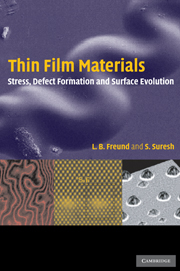Book contents
- Frontmatter
- Contents
- Preface
- 1 Introduction and Overview
- 2 Film stress and substrate curvature
- 3 Stress in anisotropic and patterned films
- 4 Delamination and fracture
- 5 Film buckling, bulging and peeling
- 6 Dislocation formation in epitaxial systems
- 7 Dislocation interactions and strain relaxation
- 8 Equilibrium and stability of surfaces
- 9 The role of stress in mass transport
- References
- Author index
- Subject index
5 - Film buckling, bulging and peeling
Published online by Cambridge University Press: 06 July 2010
- Frontmatter
- Contents
- Preface
- 1 Introduction and Overview
- 2 Film stress and substrate curvature
- 3 Stress in anisotropic and patterned films
- 4 Delamination and fracture
- 5 Film buckling, bulging and peeling
- 6 Dislocation formation in epitaxial systems
- 7 Dislocation interactions and strain relaxation
- 8 Equilibrium and stability of surfaces
- 9 The role of stress in mass transport
- References
- Author index
- Subject index
Summary
Interface delamination and film fracture induced by residual stress in the thin film were the focus of discussion in the preceding chapter where models were developed within the framework of linear elastic fracture mechanics. Such analyses did not account for the actual separation of the film from its substrate. However, there are delamination processes for which transverse deflection of the film away from the substrate becomes an important consideration in a variety of practical applications. Examples include:
– transverse buckling instability of a film in compression, as in the case of a ceramic thermal barrier coating or a diamond-like carbon wear resistant coating on a metallic substrate, as illustrated in Figure 5.1,
– the bulging of a segment of a thin film away from the substrate under the influence of an applied pressure, which is a deformation mode of interest for the assessment of residual stress, interface fracture energy and mechanical properties in film–substrate systems and MEMS structures, and
– the forcible peeling of a film from its substrate as a means of evaluating the adhesion energy of the interface between the film and the substrate.
This chapter deals with the transverse or out-of-plane deflection of a thin film, and it includes quantitative descriptions of the phenomena associated with the buckling, bulging or peeling of a film from its substrate. A common thread throughout the discussion is that system behavior extends beyond the range of geometrically linear deformation.
- Type
- Chapter
- Information
- Thin Film MaterialsStress, Defect Formation and Surface Evolution, pp. 312 - 386Publisher: Cambridge University PressPrint publication year: 2004



